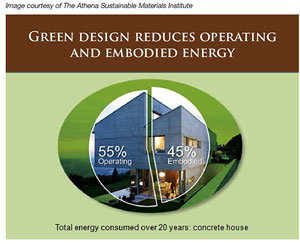Materials In Action
Wood’s advantages during construction stem from its flexibility in enabling a contractor to make modifications on site—including everything from a building’s orientation to its floor plan, number of rooms, interior design, and overall appearance. In addition, timber’s thermal efficiency means walls can be slimmer, creating more usable floor space.10
In terms of sustainability documentation, wood, and only certified wood, can come with a chain of custody that verifies it is sourced from sustainably managed forests and other responsible sources (e.g., recycled content). Forest products are tracked throughout the entire supply chain from harvesting, processing and transportation to the end consumer.
Another pressing issue during construction is the availability of materials and the impacts of getting the materials to the site. While the materials that go into cement—lime, iron, silica, alumina, and fly ash—are not often local, cement makes up only 15 percent of concrete. Steel and wood typically require a greater transport effort. A recent study on the matter was conducted in accordance with the UK’s PAS 2050 (Publicly Available Specification), a measurement tool/protocol for companies to make credible decisions based on a product’s greenhouse gas emissions. The study, by The Athena Sustainable Materials Institute and FPInnovations on the carbon footprint of transporting wood products from British Columbia, Canada to the UK, showed that, despite being transported more than 9,900 miles, the four types of wood under study—softwood lumber, softwood plywood, western red cedar lumber and western red cedar siding—represent a net carbon sink upon delivery; that is, each product stores more carbon than is emitted during its respective harvest, manufacture and transport. Unlike wood, steel has no such carbon storage capacity to offset the environmental costs of transportation.
Materials in the Use Phase
Buildings represent the highest form of energy usage in North America. According to the U.S. Department of Energy, buildings account for 38 percent of total U.S. energy consumption, more than industrial and transportation usage combined, and more than 70 percent of United States electricity consumption.
Energy Terms
Certain terms related to the use phase should be understood, and distinctions made between embodied and operating energy and their interrelation.

There are two forms of embodied energy in buildings: initial embodied energy and recurring embodied energy. For building materials, initial embodied energy is the non-renewable energy consumed in raw material acquisition, processing, manufacturing, transportation to site, and construction. Recurring embodied energy is the non-renewable energy consumed to maintain, repair, restore, refurbish or replace materials, components or systems during the life of the building. Recurring embodied energy is related to the durability of the building materials, the building’s components and systems, how well these are maintained, and the life of the building.
Operating energy refers to the energy buildings consume for heating, cooling, ventilation, lighting, equipment and appliances. Increased insulation in foundations, walls, doors, and windows may improve the operating efficiency of a structure, but the insulation products themselves may increase the structure’s embodied energy. Appreciating—and balancing—the need to reduce operating energy in buildings and its effect on embodied energy is critical to true sustainability.
Energy performance of buildings depends more on insulation, air sealing and other factors than the choice of structural material. All buildings are typically insulated well, so they tend to have essentially comparable energy performance. However, a building's embodied energy is very much affected by its structural material. The chart above is based on life cycle assessment (LCA) with calculations by The Athena Sustainable Materials Institute for identical 2,400-square-foot homes designed according to standard practice in the locales for which they were intended. Over 60 years, the wood house had less embodied energy than the concrete or steel-framed structures. Concrete structures had the highest embodied energy. For further information on the study and its assumptions, see the Canadian Wood Council’s Energy and the Environment in Residential Construction.
According to the NAHB Research Center, insulated concrete forms (ICF), rigid plastic foam forms that hold concrete during curing and remain afterwards to serve as thermal insulation for concrete walls, are superior insulators to standard concrete. Typical insulation values for ICFs range from R-17 to R-26, compared to between R-13 and R-19 for most wood-framed walls. The higher the R-value, the more thermal resistance.
 But materials with a heavy carbon footprint like concrete can really skew the balance between embodied and operating energy. As shown in the accompanying graphic, a typical concrete house has nearly as much energy embodied in the materials as it takes to run the house for 20 years. If the embodied energy is increased by adding much more insulation, it is important to make sure that the savings in heating energy will be greater than the embodied energy in the insulation. As building operations become more and more energy efficient, the embodied energy may even be eventually larger than the operating energy.
But materials with a heavy carbon footprint like concrete can really skew the balance between embodied and operating energy. As shown in the accompanying graphic, a typical concrete house has nearly as much energy embodied in the materials as it takes to run the house for 20 years. If the embodied energy is increased by adding much more insulation, it is important to make sure that the savings in heating energy will be greater than the embodied energy in the insulation. As building operations become more and more energy efficient, the embodied energy may even be eventually larger than the operating energy.









